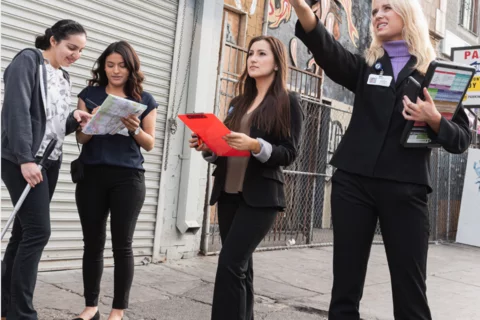Public Health Rotations: Students experience firsthand how where you live impacts health

The 14 undergraduates have completed most of their clinical and classroom coursework when they began their Public Health assignment on Skid Row. Here they have spent several Wednesdays picking their way through the clusters of sidewalk-blocking tents and measuring curb heights and vehicle speeds as part of an assessment of street safety issues facing some of the city’s most vulnerable residents.
“I honestly didn’t understand why we were being required to do this,” nursing student Ayden Loughley said when he first learned of his assignment. “But when I came down here and saw what people living on Skid Row have to deal with and how it affects their health, I began to understand why this is important.”
UCLA nursing students are required to participate in one of several public health rotations to give them a better perspective on obstacles that some of their future patients experience.
In addition to the street safety assessment, past and present rotations have included a nutrition assessment of food served at the missions on Skid Row, a walkability study of a neighborhood in Highland Park, work with low-income mothers and their children at the Hope Street Family Center in downtown Los Angeles and a survey of accessibility to prenatal care in Pico Rivera.
Each of the 10-week public health rotations, for senior bachelor’s degree and master’s degree students, consists of eight hours a week in a community setting, plus clinical and classroom work. Students, between 9 and 14 to a group, are assigned by administrators to one of the community sites or at UCLA working on one of its Healthy Campus initiatives.
Dr. Dorothy J. Wiley, who leads the public health component, said the community experiences have been eye-opening for students, many of whom have grown up with little exposure to the stressors low-income families face. And how issues in their communities – such as a scarcity of nutritious food or a lack of access to prenatal care – can lead to illness and hospital stays.
“Most nurses spend the majority of their time in clinics and hospitals,” Wiley said. “But patients don’t live in those places.”
So it’s really important, Wiley said, that students understand the circumstances and health challenges their patients face in the community.
She said she has two primary goals for the program:
“First, I want our students to become better citizens,” to have a “better appreciation for others, whatever ‘other’ is. That is important to me.” In addition, she wants students to see that “we, as a profession, are always talking about keeping everybody well when much of our employment is in an illness setting.”
“It’s very hard,” she continued, “for students to pull back and see that much of the illness in this country is related to systems and community.”
Wiley believes the public health rotations go a long way toward helping students make that connection.
She sees the street safety project, for example, as “a tangible piece of work that students can get their heads around. They really learn a lot.”
At their “headquarters” in the conference room at the Courtland Hotel one Wednesday afternoon, the students were discussing their work in the traffic safety study, a large map of Skid Row on a wall within view of their rectangular table. They were entering data into spreadsheets and planned to give the finished work to City Councilman Jose Huizar who represents Skid Row.
“I hadn’t really thought about how traffic patterns affected people’s health,” said Emily Bloom, “how people are getting hurt on the streets” if tents force them off sidewalks and curbs are too high for wheelchairs to negotiate.”
“When we are working in the hospital, we see patients when they are already sick,” said Julia Wenzel. “Here we are looking to prevent injury and illness. We can see how someone in a wheelchair is having trouble getting to a doctor. I’m really glad that I got a chance to see the big picture.“
“It’s a much more holistic approach,” added Jane Ly. “We can see the connections and hopefully do something about them.”
Antonella Ortega said she had been to Skid Row before the rotation, so conditions there were not as shocking to her as they were to some of her classmates. But she said she had not previously looked at the neighborhood from a public health and safety perspective, and that was eye opening.
“I had not thought about that before,” Ortega said.
Wiley said she also hopes that students’ better understanding of their patients’ community circumstances will make them not only more compassionate but also more effective.